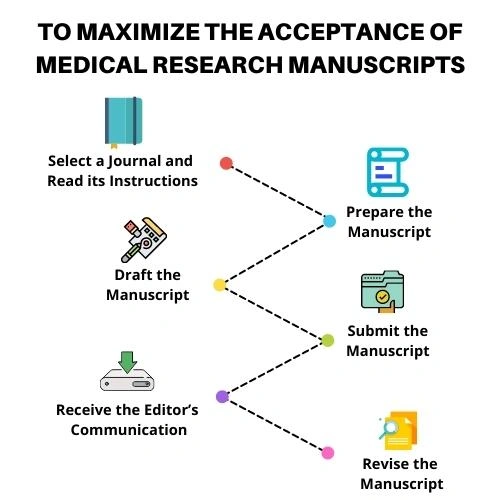The method used to maximize the acceptance of your medical research manuscripts
In brief:
- While drafting a manuscript gives at most importance to plagiarism check, it shows the originality of the document.
- Avoid replacing content in the wrong area, which can confuse the reviewers, for example, do not define incomplete results in the method section and avoid the assumption of data in the Results section.
- Extensive literature review helps to overcome plagiarism issues, it gives an idea about the current research work carried out in the research area, and you can have a clear idea about your research area.

Introduction:
Several strategies used for manuscript writing; one of them is writing method first then followed by the result, discussion and introduction sections. The simplest section of manuscript writing is a method section because you have some idea about the study design and so that you can quickly draft with appropriate subheadings. The subheading used in the result section some time directly reflects the subheading in the method section. Use of reference management software allows for easy insertion and removal reference. It also helps in numbering the references.
Confirm Authors, Select a Journal, and Read the Journal’s Instructions
While preparing the manuscript, it is always necessary to follow all the journal requirements, including word counts, the number of tables and figures used in the document. For example, the word limit for ASO is 2500, without the title page, abstract, and references. It only allows five figures and tables per manuscript. So it is necessary to plan for the total number of tables and figures which need to be included in the paper. Several journals, comprising ASO, allow supplemental material to be submitted as part of your manuscript, which does not have the word count, figures and tables. Proofreading scientific documents increase the chance of manuscript to get selected in the reputed journal and increase the research work scope.
Prepare the Manuscript
Use of subheadings in methods and the result section often help the reader. Avoid replacing content in the wrong area, which can confuse the reviewers, for example, do not define incomplete results in the method section and avoid the assumption of data in the Results section. Such fundamental errors are quickly identified by the researcher and often result in rejection of the manuscript, keep this basic structure in mind and start outlining the manuscript. The first primitive draft must contain important points to describe under each section and subheading and cross-check whether you have mentioned it in the correct section and subheading. Then determine you have expressed it with a correct logical sequence. It provides you with a rough draft of the manuscript, avoids sloppy and lengthy manuscript.

Draft the Manuscript
While drafting a manuscript gives at most importance to plagiarism check, it shows the originality of the document. Extensive literature help to overcome plagiarism issues, it gives an idea about the current research work carried out in the research area, and you can have a clear idea about your research area. The literature review must not summarise other author work; you have to relate how that theory or methodology was used in your career. Write a Theoretical Framework literature survey which shows the reviewer that you have a better understanding of the research area.
Submit the Manuscript
Nowadays most of the research papers are submitted online, in the particular journal website. At the time of submission, most of the journal suggests the author who should review and who should not and such suggestion helps the journals’ editorial staff. Give at most important to the title and keywords which attracts the reader. Do not submit the same manuscript in different journals at the same time because doing so violates scientific publishing ethics.
Receive the Editor’s Communication and Revise the Manuscript
Manuscript acceptance at the first time of submission is widespread; do not worry if your work got rejected for the first time. Top journals accept less than one in four manuscripts. If you have a command to revise the work or resubmit the document, give significance, carefully check the work and make necessary changes in the manuscript. Revision process consistently improves the manuscript. If you feel some revision is injustice, state why it is so and writes it straightforwardly in the response letter. However, most of the reviewer and editorial members are selected from top journals, experienced experts and therefore, carefully give the contradictory review.
How to write a manuscript for a research paper?
1) Research the significance of your research work and how it fits into the existing literature
- What do you know about the topic?
- What are the facts you still do not know?
- Why is knowledge significant?
2) Understand the target audience
How does medical manuscript writing services help?
A medical manuscript writing service puts your research thoughts in the exact path by:
- Properly organize your research results
- Check and correct all language errors
- Help to get a précised and clear research thought.
- Improve the excellence of your research communication
Conclusion:
Manuscript preparation is a long and complicated process, the necessary to include error-free and plagiarism-free content inside the manuscript, which shows the originality of the work and improves the scope of the research work. So you can also get editorial help from Manuscript editing service and scientific manuscript editing services and consult experts from the same research area to get precise research work.
References:
- Singer, A. J., & Hollander, J. E. (2009). How to write a manuscript. The journal of emergency medicine, 36(1), 89-93.
- Setiati, S., & Harimurti, K. (2007). Writing for scientific medical manuscript: a guide for preparing manuscript submitted to biomedical journals. Acta Med Indones, 39(1), 50-5.
- Bajwa, S. J. S., & Sawhney, C. (2016). Preparing manuscript: Scientific writing for publication. Indian journal of anaesthesia, 60(9), 674.

 Previous Post
Previous Post Next Post
Next Post